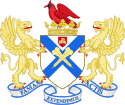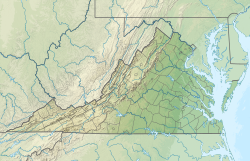
A | B | C | D | E | F | G | H | CH | I | J | K | L | M | N | O | P | Q | R | S | T | U | V | W | X | Y | Z | 0 | 1 | 2 | 3 | 4 | 5 | 6 | 7 | 8 | 9
Fredericksburg, Virginia | |
|---|---|
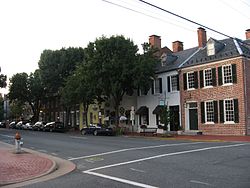 Historic Downtown Fredericksburg | |
| Motto: America's Most Historic City | |
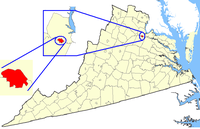 Location of Fredericksburg in Northern Virginia | |
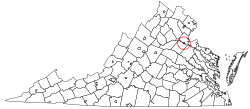 Fredericksburg in Virginia | |
| Coordinates: 38°18′6.5″N 77°28′15″W / 38.301806°N 77.47083°W | |
| Country | United States |
| State | Virginia |
| County | None (Independent city since 1879, adjacent to Spotsylvania County) |
| Founded | 1728 |
| Incorporated | 1781 |
| Named for | Frederick, Prince of Wales |
| Government | |
| • Mayor | Kerry P. Devine |
| Area | |
| • Independent city | 10.52 sq mi (27.24 km2) |
| • Land | 10.45 sq mi (27.07 km2) |
| • Water | 0.07 sq mi (0.18 km2) |
| Elevation | 59 ft (18 m) |
| Population (2020) | |
| • Independent city | 27,982 |
| • Density | 2,700/sq mi (1,000/km2) |
| • Urban | 167,679 (US: 216th) |
| Time zone | UTC−05:00 (Eastern (EST)) |
| • Summer (DST) | UTC−04:00 (EDT) |
| ZIP Codes | 22401 (USPS designates 5 zip codes for Fredericksburg, but 4 of them lie outside the Independent City in surrounding counties; only 22401 lies inside it) |
| Area code | 540 |
| FIPS code | 51-29744[2] |
| GNIS feature ID | 1494947[3] |
| Website | www |
| * Independent from Spotsylvania County in 1879 | |
Fredericksburg is an independent city in Virginia, United States. As of the 2020 census, the population was 27,982.[4] It is 48 miles (77 km) south of Washington, D.C., and 53 miles (85 km) north of Richmond.[5][6] The Bureau of Economic Analysis of the United States Department of Commerce combines the city of Fredericksburg with neighboring Spotsylvania County for statistical purposes.
Located near where the Rappahannock River crosses the Atlantic Seaboard fall line, Fredericksburg was a prominent port in Virginia during the colonial era. During the Civil War, Fredericksburg, located halfway between the capitals of the opposing forces, was the site of the Battle of Fredericksburg and Second Battle of Fredericksburg. These battles are preserved, in part, as the Fredericksburg and Spotsylvania National Military Park. More than 10,000 African-Americans in the region left slavery for freedom in 1862 alone, getting behind Union lines. Tourism is a major part of the economy. Approximately 1.5 million people visit the Fredericksburg area annually, including the battlefield park, the downtown visitor center, events, museums, art shops, galleries, and many historical sites.[7]
Fredericksburg is home to Central Park (as of 2004, the second-largest mall on the East Coast). The Spotsylvania Towne Centre is located in Spotsylvania County, adjacent to the city. Major employers include the University of Mary Washington (named for the mother of George Washington, who lived here), Mary Washington Healthcare, and GEICO. Many Fredericksburg area residents commute to work by car, bus, and rail to Washington, D.C., and Richmond, as well as Fairfax, Prince William, and Arlington counties.[8][9][10][11]
History
At the time of European encounter, the indigenous inhabitants of the area that became Fredericksburg were a Siouan-speaking tribe called the Manahoac. English colonists recorded the name of the Manahoac village there as Mahaskahod.[12] Siouan tribes occupied much of the area of the Piedmont. The Tidewater areas of the coastal plain had primarily Algonquian-speaking tribes making up the Powhatan Confederacy.
Colonial
Located on the Rappahannock River near the head of navigation at the fall line, Fredericksburg developed as the frontier of colonial Virginia shifted west from the coastal plain into the Piedmont. The land on which the city was founded was part of a tract patented in 1671. The Virginia General Assembly established a fort on the Rappahannock in 1676, just downriver of the present-day city. In 1714, Lieutenant Governor Alexander Spotswood sponsored a German settlement called Germanna on the Rapidan River, a tributary of the Rappahannock upstream from the future site of the city. In 1716, he led an exploratory expedition westward over the Blue Ridge Mountains.
As interest in the frontier grew, the colonial assembly formed Spotsylvania County in 1720, named after Royal Lieutenant Governor Alexander Spotswood. In 1728, Fredericksburg was declared a port for the county, of which it was then a part. Named for Frederick, Prince of Wales,[13] son of King George II, the colonial town named its streets after the members of the royal family. The county court was moved to Fredericksburg in 1732. Hence, the community served as county seat until 1780. The court was then moved to Spotsylvania Courthouse, Virginia – closer to the geographical center of Spotsylvania County. In 1781, Fredericksburg was incorporated as a town with its own court, council, and mayor. It received its charter as an independent city in 1879 and under Virginia law, was separated from Spotsylvania County. The city adopted its present city manager/council form of government in 1911.
The city has close associations with George Washington, whose family in 1738 moved to Ferry Farm in Stafford County near the Rappahannock River opposite Fredericksburg. Washington's mother, Mary, later moved to the city, and his sister Betty lived at Kenmore, a plantation house then outside the city. Several citizens played active roles during the American Revolution (1763–1781). For example, a number of locals signed the Leedstown Resolves, which formed an association to protest the Stamp Act in the 1760s.[14] In the 1770s, Fielding Lewis, owner of Kenmore Plantation and brother-in-law to George Washington, also operated an arms factory for the Continental Army. Other significant early residents include the Revolutionary War generals Hugh Mercer and George Weedon, naval war hero John Paul Jones, and future U.S. president James Monroe. Thomas Jefferson wrote the Virginia Statute for Religious Freedom in Fredericksburg.[citation needed]
19th century


During the 19th century, mills continued to be developed along the Rappahannock River, which provided water power. There were mills for grinding flour, processing and weaving cotton, and other manufacturing. Fredericksburg sought to maintain its sphere of trade, but with limited success. It promoted the development of a canal on the Rappahannock and construction of a turnpike and plank road to bind the interior country to the market town. By 1837, a north–south railroad, which became the Richmond, Fredericksburg and Potomac Railroad, linked the town to Richmond, the state capital. A much-needed railroad joining the town to the West's arming region was not finished until after the Civil War.
During the Civil War, Fredericksburg was strategically important because of its port location midway between Washington and Richmond, the opposing capitals of the Union and the Confederacy. During the Battle of Fredericksburg from December 11–15, 1862, the town sustained significant damage from bombardment and looting by the Union forces.
During that engagement, nearly 10,000 enslaved people left area plantations and city households to gain freedom by crossing the Rappahannock River to Stafford County and join the Union lines, part of a movement by enslaved people throughout the South in wartime.[15] John Washington, a literate enslaved person who shortly crossed to freedom, wrote later about people watching the approach of Union troops across the river from Fredericksburg: "No one could be seen on the street but the colored people. and every one of them seemed to be in the best of humors."[16]
The Second Battle of Fredericksburg was fought in and around the town on May 3, 1863, in connection with the Chancellorsville campaign (April 27, 1863 – May 6, 1863). The battles of the Wilderness and Spotsylvania Court House were fought nearby in May 1864. The Washington Woolen Mill, a large three-story building, was converted to use as a hospital during the war.
After the war, Fredericksburg recovered its former position as a center of local trade and slowly grew beyond its prewar boundaries. Neither the city of Fredericksburg nor the surrounding counties reached the 1860 level of population again until well into the 20th century. After the war, many freedmen moved to Richmond and Petersburg, where there had been established free black communities before the war, and there was more work.
20th century to present
In the early 20th century, as the Jim Crow era continued in the South, there was widespread population movement. Many African-Americans left rural areas of the South for work and other opportunities in industrial cities of the North and Midwest in the Great Migration. Some settled in Washington, D.C., where there were more opportunities, or further north.
War-related buildup at defense facilities for World War II added to the area's population in the 1940s. The 1960s brought renewed growth and development, fueled by the construction of Interstate 95, which eased commuting and trade. By the 1970s, the city and the area had become a bedroom community for jobs in Northern Virginia and Washington, D.C. Headquarters agencies, lobbyists, consultants, defense and government contractors, and a range of other businesses were part of the regional economy influenced by the U.S. government. The city also benefited from its relative proximity to four military installations: the United States Marine Corps' Quantico Base, the U.S. Army's Fort Belvoir, the U.S. Navy's Dahlgren Surface Weapons Base, and the Virginia National Guard's Fort A.P. Hill.
The University of Mary Washington was founded in Fredericksburg in 1908 as the State Normal and Industrial School for Women, to train white women for teaching K-12 and industrial skills. Adopting the name of Mary Washington College in 1938, the college was for many years associated with the University of Virginia (then limited to white men) as a women's liberal arts college. The college officially desegregated in 1964. The college became independent of the University of Virginia and began to accept men in 1970. In 2004, the college changed its name from Mary Washington College to the University of Mary Washington. Two additional campuses for graduate and professional studies and education and research are located in Stafford County and in King George County, respectively.
Musician Link Wray invented the power chord of modern rock guitar in Fredericksburg in 1958 during an improvisation of the instrumental piece "Rumble", a single subsequently released by Wray & His Ray Men.[17] This innovation became widely used by rock guitarists. In the early 21st century, the local music scene includes a wide variety of genres.
A commuter rail line – the Virginia Railway Express – was established in the 1980s, providing passage to Washington, D.C. and other cities north of Fredericksburg.
The city has become the regional healthcare center for the area. Retail, real estate, and other commercial growth exploded in the early 21st century, eventually slowing during the Great Recession beginning in 2007. Hispanic growth skyrocketed from 2011 to 2020, with Chancellor Green in nearby Spotsylvania County becoming a local enclave.[citation needed]
Geography and climate
According to the U.S. Census Bureau, the city has a total area of 10.5 square miles (27.2 km2), 10.4 square miles (27.0 km2) of which is land and 0.1 square miles (0.2 km2), or 0.67%, of which is water.[18] The city is part of the boundary between the Piedmont and Tidewater regions, and as such is located on the fall line, as evident on the Rappahannock River. US 1, US 17, and I-95 all pass through the city, which is located 53 miles (85 km) south of downtown Washington, D.C.
The city is bounded on the north and east by the Rappahannock River; across the river is Stafford County. The city is bounded on the south and west by Spotsylvania County.
Fredericksburg has a four-season humid subtropical climate (Köppen Cfa), with cool winters and hot, humid summers. Daytime temperatures for much of the year average slightly higher than in Washington, D.C. due to the southerly aspect, although the inland location and distance from the urban heat island present in the nation's capital make for significantly cooler low temperatures.
| Climate data for Fredericksburg, Virginia (downtown, 1991−2020 normals, extremes 1995–present) | |||||||||||||
|---|---|---|---|---|---|---|---|---|---|---|---|---|---|
| Month | Jan | Feb | Mar | Apr | May | Jun | Jul | Aug | Sep | Oct | Nov | Dec | Year |
| Record high °F (°C) | 82 (28) |
80 (27) |
90 (32) |
95 (35) |
96 (36) |
102 (39) |
102 (39) |
103 (39) |
98 (37) |
96 (36) |
83 (28) |
80 (27) |
103 (39) |
| Mean daily maximum °F (°C) | 45.9 (7.7) |
49.3 (9.6) |
57.0 (13.9) |
68.5 (20.3) |
76.1 (24.5) |
84.3 (29.1) |
88.5 (31.4) |
86.6 (30.3) |
80.3 (26.8) |
70.0 (21.1) |
58.9 (14.9) |
50.0 (10.0) |
67.9 (19.9) |
| Daily mean °F (°C) | 35.5 (1.9) |
38.1 (3.4) |
45.3 (7.4) |
56.1 (13.4) |
64.6 (18.1) |
73.6 (23.1) |
78.1 (25.6) |
76.3 (24.6) |
69.6 (20.9) |
58.1 (14.5) |
47.1 (8.4) |
39.2 (4.0) |
56.8 (13.8) |
| Mean daily minimum °F (°C) | 25.1 (−3.8) |
26.9 (−2.8) |
33.5 (0.8) |
43.6 (6.4) |
53.2 (11.8) |
62.9 (17.2) |
67.6 (19.8) |
65.9 (18.8) |
58.9 (14.9) |
46.2 (7.9) |
35.2 (1.8) |
28.3 (−2.1) |
45.6 (7.6) |
| Record low °F (°C) | −4 (−20) |
−8 (−22) |
5 (−15) |
20 (−7) |
32 (0) |
45 (7) |
53 (12) |
51 (11) |
42 (6) |
28 (−2) |
17 (−8) |
7 (−14) |
−8 (−22) |
| Average precipitation inches (mm) | 2.72 (69) |
2.50 (64) |
3.96 (101) |
3.37 (86) |
4.19 (106) |
3.88 (99) |
4.82 (122) |
2.99 (76) |
4.54 (115) |
3.72 (94) |
3.52 (89) |
3.19 (81) |
43.40 (1,102) |
| Average snowfall inches (cm) | 3.7 (9.4) |
5.2 (13) |
0.1 (0.25) |
0.0 (0.0) |
0.0 (0.0) |
0.0 (0.0) |
0.0 (0.0) |
0.0 (0.0) |
0.0 (0.0) |
0.0 (0.0) |
0.0 (0.0) |
2.3 (5.8) |
11.3 (29) |
| Average precipitation days (≥ 0.01 in) | 9.2 | 7.2 | 9.4 | 9.7 | 12.8 | 10.5 | 9.8 | 9.7 | 8.3 | 8.9 | 8.5 | 9.0 | 113.0 |
| Average snowy days (≥ 0.1 in) | 1.4 | 1.1 | 0.3 | 0.0 | 0.0 | 0.0 | 0.0 | 0.0 | 0.0 | 0.0 | 0.0 | 0.5 | 3.3 |
| Source: NOAA[19][20] | |||||||||||||
Demographics
| Census | Pop. | Note | %± |
|---|---|---|---|
| 1830 | 3,308 | — | |
| 1840 | 3,974 | 20.1% | |
| 1850 | 4,061 | 2.2% | |
| 1860 | 5,022 | 23.7% | |
| 1870 | 4,046 | −19.4% | |
| 1880 | 5,010 | 23.8% | |
| 1890 | 4,528 | −9.6% | |
| 1900 | 5,068 | 11.9% | |
| 1910 | 5,874 | 15.9% | |
| 1920 | 5,882 | 0.1% | |
| 1930 | 6,819 | 15.9% | |
| 1940 | 10,066 | 47.6% | |
| 1950 | 12,158 | 20.8% | |
| 1960 | 13,639 | 12.2% | |
| 1970 | 14,450 | 5.9% | |
| 1980 | 15,322 | 6.0% | |
| 1990 | 19,027 | 24.2% | |
| 2000 | 19,279 | 1.3% | |
| 2010 | 24,286 | 26.0% | |
| 2020 | 27,982 | 15.2% | |
| U.S. Decennial Census[21] 1790–1960[22] 1900–1990[23] 1990–2000[24] 2010–2020[25] | |||
2020 census
| Race / Ethnicity | Pop 2010[26] | Pop 2020[27] | % 2010 | % 2020 |
|---|---|---|---|---|
| White alone (NH) | 14,760 | 15,201 | 60.78% | 54.32% |
| Black or African American alone (NH) | 5,367 | 5,956 | 22.10% | 21.29% |
| Native American or Alaska Native alone (NH) | 58 | 86 | 0.24% | 0.31% |
| Asian alone (NH) | 670 | 1,325 | 2.76% | 4.74% |
| Pacific Islander alone (NH) | 16 | 24 | 0.07% | 0.09% |
| Some Other Race alone (NH) | 64 | 280 | 0.26% | 1.00% |
| Mixed Race/Multi-Racial (NH) | 744 | 1,638 | 3.06% | 5.85% |
| Hispanic or Latino (any race) | 2,607 | 3,472 | 10.73% | 12.41% |
| Total | 24,286 | 27,982 | 100.00% | 100.00% |
Note: the US Census treats Hispanic/Latino as an ethnic category. This table excludes Latinos from the racial categories and assigns them to a separate category. Hispanics/Latinos can be of any race.
As of the census[28] of 2020, there were about 29,000 people, 8,102 households, and 3,925 families residing in the city. The population density was 1,833 inhabitants per square mile (708/km2). There were 8,888 housing units at an average density of 845 per square mile (326/km2). The racial makeup of the city was 54% White, 21% Black or African American, 0.31% Native American, 4.74 Asian, 0.067 Pacific Islander, 2.56% from other races, and 1.95% from two or more races.12% of the population were Hispanic or Latino of any race.
There were 8,102 households, out of which 21.6% had children under the age of 18 living with them, 31.8% were married couples living together, 13.1% had a female householder with no husband present, and 51.6% were non-families. 39.2% of all households were made up of individuals, and 12.8% had someone living alone who was 65 years of age or older. The average household size was 2.09 and the average family size was 2.81.
In the city, the population was spread out, with 17.8% under the age of 18, 23.8% from 18 to 24, 27.2% from 25 to 44, 18.4% from 45 to 64, and 12.8% who were 65 years of age or older. The median age was 30 years. For every 100 females, there were 81.8 males. For every 100 females age 18 and over, there were 78.4 males.
According to data from the US Census, the median household income in the city is $83,445 and the median income for a family is $121,781.[29] The per capita income for the city is $43,063. 18% of the population is below the poverty line.[30]
Crime
The Fredericksburg Police Department[31] tracks crime information under the state-level system of the Uniform Crime Reporting program.[note 1] Per state code, the central repository for crime statistics rests with the Department of State Police, which compiles data from all of the participating agencies into an annual publication Archived November 25, 2011, at the Wayback Machine.[32]
Politics
By long-standing tradition (dating back to the Federal Hatch Act of 1939, which prohibited government employees from participating in partisan politics), local elections in Fredericksburg are officially non-partisan. Neither the mayoral and council elections nor local constitutional positions (e.g. sheriff, Commissioner of Revenue, Commonwealth Attorney) list candidates with a party label.



